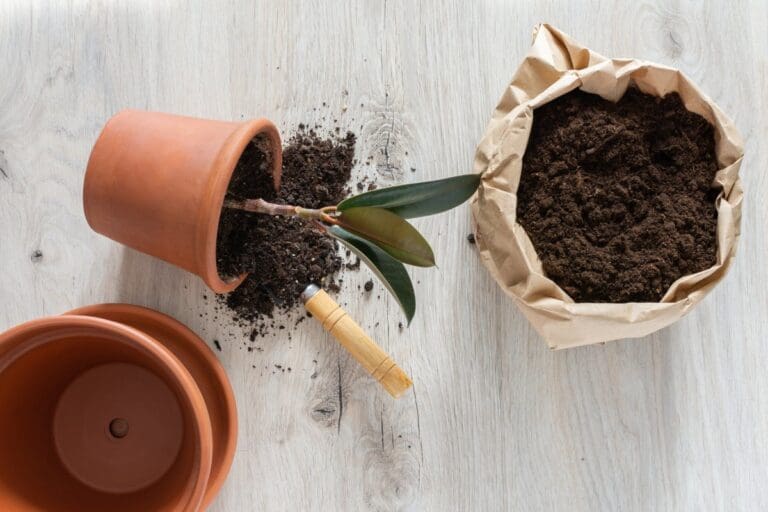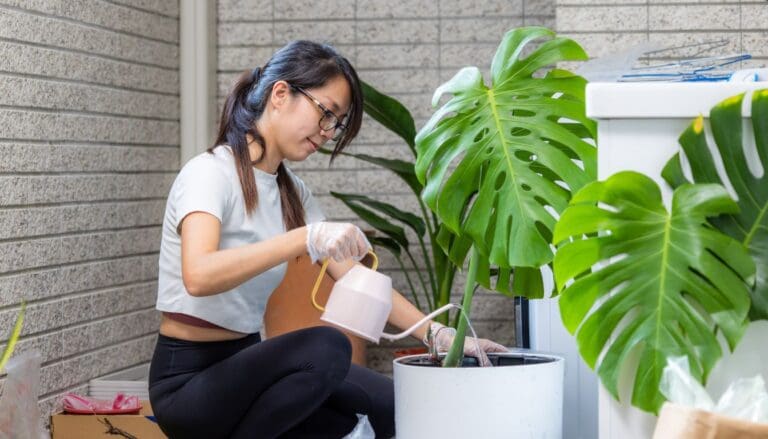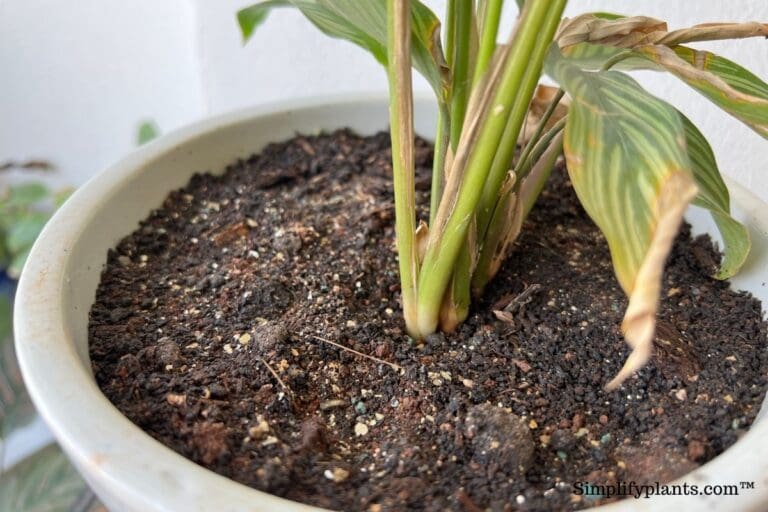When To Throw Away A Plant? (4 Circumstances)
Plant lovers always try to gather more and more plants in their collections. They go crazy whenever they visit stores. But, it is sad for them when a situation arrives where they have to throw away the plant. Now, what are those circumstances where the plant requires dumping? Let’s read.
You need to throw your plant away in two common situations: pest invasion and fungal infections. You don’t have any option but to throw it away if the infestation or disease is extreme and revival seems impossible. Sometimes the plant dies for natural reasons; even then, you need to throw it away.
This article will take you through the situations where you should throw a plant and why. We will also help you know whether a plant needs to be thrown away or not.

Please note: Simplify Plants is reader-supported. Some links in the post are affiliate links and I get a commission from purchases made through links in the post.
Do I need to throw away plants?
When a plant gets old or is invaded by bugs or fungus, it is necessary to throw away a plant.
These plants are not long recoverable and cannot be used for good purposes.
So, you need to dump them in your garbage or burn and bury them.
However, before you throw them, you must ask yourself the question once.
Do you need to dump these plants?
Sometimes, you don’t have to dump the old or dead plants.
You can dispose of them eco-friendly by making compost or mulch out of the plant parts.
Though the plant may seem dead, they hold a lot of good nutrients.
Adding them to the compost pile or breaking them down into pieces to use as mulch are good ways to utilize the plant remnants.
You can also use the plant parts in artwork for home decor.
Now let’s see when and why the plants need to be thrown away.
Also read: How To Dispose Of Potted Plants? (8 Unique Ways)
When should I throw away my plant?

There are generally 4 main circumstances where you must throw away the plants:
- When bugs infest a plant
- When diseases infect a plant
- When a plant dies naturally
- When a plant is in bad health
Bug infested plant
When a plant gets infected by bugs like aphids, mites, scales, or thrips, first, you should try to treat the plant with several insecticides and pesticides.
If the infestation is small or medium, you still have a chance to recover the plant.
But suppose the infestation is so serious that all the leaves get eaten up and skeletonized or discolored and dry.
In that case, it is time to throw away the plant.
The bugs will enter the roots and start feeding on them in severe conditions.
If the roots get damaged, there is no way of saving the plants.
Though you can treat most bugs, some bugs enter the plant tissues and damage the plant entirely from the inside.
In such a situation, there is no possibility of saving it.
So, when a plant is severely injured by a pest attack and dies, you must throw it away.
You should dump the plant in your nearby dumping site or garbage, or you should burn or bury them.
It would be best to never use these plants for composting or mulching.
Though many people use them as compost, I don’t recommend it.
If you want the same plant back, buying again is the best option.
Or, if a few parts are left in good condition, you can cut them and start propagating the plant to get the same plant.
Diseased plant

A lot of diseases can kill the plant.
One of the most common diseases is root rot caused due to repeated overwatering.
Excessive overwatering makes the roots soft and mushy: over time, they begin to rot.
When most of the roots have rotted, it becomes impossible to save the plant.
In such a circumstance, you don’t get any choice other than dumping the plant.
Other diseases like crown rot and botrytis blight will also kill the plant because they are difficult to treat.
If you don’t take immediate action, the infection will slowly spread to the whole plant and kill it.
Reviving the plant will become impossible.
It would be best to throw these kinds of plants.
Otherwise, if you use the plant parts as mulch or compost, the plants where you use these mulches and compost will also get affected by the diseases.
Many people use these plants as compost.
While composting, the temperature needs to reach 150-180°F, enough to kill pathogens and pests.
But sometimes, the temperature doesn’t reach this level, for which the pathogens stay alive.
So, it is better to discard them.
Precaution is better than cure.
So, burn, bury, or throw them to the dumping ground.
Naturally dead plants
Sometimes, some plants will die due to natural reasons.
When a plant starts to grow flowers and produces seeds, the plant will begin to die.
That is why most growers cut off the flowers once they begin to fade.
The more you trim the faded flowers, the longer your plant stays alive.
If you don’t trim the faded flowers and allow them to produce seeds, your plant will die after the plant starts to produce the seeds.
In such a case, you will have to throw away the plant and grow new plants from the seeds.
If a plant has become old and its lifespan has ended, it will die naturally and won’t come back.
For example, annual plants stay alive for only 1 year.
If they germinate and produce flowers in spring, they will die in autumn.
Some annual plants can be grown indoors and outdoors, for instance, basil, petunias, or marigolds.
So, these plants will also need to be discarded.
However, you don’t have to throw away the plant completely.
You can dispose of the plant by not throwing it away.
If the plant has been healthy throughout, you can compost it and add it to other plants’ soil to make it more fertile.
You can use the plant parts like the dried leaves and stems for mulching your outdoor plant beds.
You can even use the dried leaves and stems for art and craft work, add them to the frames, and use them as home decor.
Plants in bad health
Sometimes, due to some care faults, the plants will die.
It could be due to watering issues, lack of nutrients or excessive fertilizers, too little sunlight, etc.
Watering issues

You have a houseplant, but you don’t care for it.
You don’t water the plant regularly, or you water them too much.
If you don’t water your plant daily, it will lack hydration.
The leaves will first become yellow or brown and then slowly dry up.
Over time, all the leaves will become droopy.
The roots will become very dry and lose their firmness.
Slowly, the plant will die.
If you overwater the plant, the roots stay in excessive water for a long time and become dark brown or black, soft and mushy.
If not noticed and taken action, all the roots will turn black and rot.
Slowly, the plant will die.
If any of this happens, you will have to dump the plant, especially in the case of overwatering, because there are high chances of a fungal disease called root rot.
Too little light
Light is essential in every plant’s life.
Without light, they fail to photosynthesize or function properly.
If a plant doesn’t photosynthesize properly, it will not develop any food.
There will be no improvement in the plant’s growth.
Slowly, the plant will begin to die and reach a level where revival will be impossible.
So, give them adequate sunlight if you want your plant to remain alive.
If you don’t do so, get ready to dump your plant.
Over-fertilization

When a plant gets over-fertilized, it receives a lot of excessive nutrients, salts, and chemicals present in the product.
This overdose can cause a dysfunction in the plant’s system and result in severe leaf discoloration or leaf loss.
If the problem is detected first, you might save your plant.
But, one day, if you see all the leaves falling off and dying after recent feeding, you have frequently overfed your plant.
Unfortunately, your plant will become impossible to save.
So, you have to throw it away.
Under-fertilization
It is less dangerous than over-fertilization, but both can kill the plant.
But, there are exceptions.
Suppose you got a houseplant whom you give only light and water but no nutrients.
In that case, the plant may remain alive, but there will not be good or bushy growth.
It will look malnourished.
If you just let the plant be without giving them adequate light, water, and fertilization, the plant will die one day.
A dead plant that becomes impossible to revive gets its place in a dumping site.
And being a plant lover, it is very saddening to see a plant dying and being dumped due to the owner’s irresponsible behavior.
In what conditions can I bring a plant back to life?

Though there are many circumstances where you should throw away a plant, you can save the plant for the last time before you decide to dump it.
A plant badly attacked by bugs or infected by fungus and bacteria is difficult to revive, especially if the plant is heavily affected.
However, you can try and save it for the last time by taking the required steps.
If a bug loves dry weather, maintain moisture in your plant.
When the bugs don’t enjoy the place anymore, they will start leaving your plant.
If a bug enjoys dark and moist weather, stop watering the plant and shift it to a sunny location to dry the soil.
The bugs will feel uncomfortable and leave your plant.
Don’t forget to apply insecticides.
The best option is Neem oil.
You may discard the sap-sucking bugs systemically.
Adding Imidacloprid to the soil can kill the bugs when they suck the plant sap next time.
If it is any disease, try to detect it and try alternatives if the infection is heavy.
For example, discard the damaged roots if it is root rot.
If many roots require removal, remove some good leaves with the damaged ones to create a balance between the roots and leaves.
A smaller amount of roots cannot give support to a lot of leaves.
If it is Botrytis, you need to observe and remove the infected parts from the plant and then apply some fungicide to remove the pathogens.
If the diseases spread too much, the fungicides won’t work.
Even if the disease diminishes, for now, it will be back again.
So, if your plant is strong enough to fight, then you can bring your plant back.
Otherwise, the only way out is the dumping area.
Final thoughts
It is not necessary to throw away the plant. But, if bugs and diseases infect a plant to a great level, you must throw away the plant. Severe problems like watering issues, light problems, and fertilization inconsistencies can kill the plant if it is facing them for a long time.
However, all these problems can be handled if caught at the initial stage. But, if they get poorly damaged, you have to dump them. When you see almost all the leaves have wilted, dried, fallen off, skeletonized, or have too many lesions, revival is impossible.
If a plant starts growing seeds, it will die. So, you have to throw that plant. You will also have to throw it away if the plant gets old and dies. You can’t get the same old plant here, but you can propagate the plant.
Reference: Livescience, Wikipedia, Planting Healthier Indoor Air.
Recommended Garden Supplies
| Product Image | Our Recommended Gardening Supplies | Check Offers! |
|---|---|---|
Top Top
Top
Top
Top
Top
Top
Top
Top | rePotme Houseplant and Tropical Classic Potting Soil Mix | Check Offer On Amazon |
 Top
Top
Top
Top
Top
Top
Top
Top | Espoma Organic Indoor Plant Food | Check Offer On Amazon |
 Top
Top
Top
Top
Top
Top
Top
Top | GooingTop LED Grow Light 6000K Full Spectrum Clip Plant Growing Lamp | Check Offer On Amazon |
 Top
Top
Top
Top
Top
Top
Top
Top | Soil Moisture Meter | Check Offer On Amazon |
 Top
Top
Top
Top
Top
Top
Top
Top | Govee Hygrometer Thermometer, Bluetooth Enabled! | Check Offer On Amazon |
 Top
Top | LEVOIT Humidifiers for Large Room(Best For Plants) | Check Offer On Amazon |
 Top
Top
Top
Top
Top
Top
Top
Top | Upgraded DIY Automatic Drip Irrigation Kit, 15 Potted Houseplants Support | Check Offer On Amazon |
 Top
Top
Top
Top
Top
Top
Top
Top | Stainless Steel Heavy Duty Gardening Tool Set | Check Offer On Amazon |
 Top
Top
Top
Top
Top
Top
Top
Top | Bonide Insecticidal Soap | Check Offer On Amazon |
 Top
Top
Top
Top
Top
Top
Top
Top | Bonide 32 oz Spray Neem Oil for Organic Gardening | Check Offer On Amazon |
 Top
Top
Top
Top
Top
Top
Top
Top | Garden Safe Fungicide | Check Offer On Amazon |






